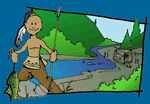


Geography and Landforms: Connecticut is the third smallest state. Only Rhode Island and Delaware have less area. A low, flat region known as the Coastal Lowlands is found along the state's southern shore with the Atlantic Ocean. It is between 6 and 16 miles wide. Several important harbors are found along the coast. They include New London, New Haven, and Greenwich. The mountainous Taconic section is located in the northwest corner of the state. Connecticut's highest point, Mt. Frissell, is located here. An area of hills, ridges and rivers known as the Western New England Upland is found in the western part of the state. This region slopes gradually from a height of 1400 feet above sea level in the northwest to just 1000 feet above sea level in the southeast. The Connecticut Valley Lowland is a 20-mile wide area in the center of the state. Small rivers separated by 300-600 foot basalt ridges are found in this lowland region. Narrow river valleys and low hills make up the Eastern New England Upland region. It is a heavily forested area in the eastern part of the state. The state's lowest point is found where Connecticut meets the Long Island Sound to the south. |
 History:
The first Europeans to land on the shores of Connecticut were Dutch traders in 1614. They set up trading posts, purchased land from the Pequot Indians, and established a fort on the site of present day Hartford in 1633. English Puritans from Plymouth, Massachusetts built a trading post in Connecticut at the site of the town of Windsor.
|
 Economy:
Since colonial times, Connecticut has been a leading industrial state. Over the years, the state has produced friction matches, submarines, lollipops, safety fuses, mechanical calculators, and sewing machines.
|
 First Inhabitants:
Thousands of Native Americans lived in what is now the state of Connecticut before European settlers came to the area. They were all part of the Algonkian Indian family. The Pequot tribe was the most powerful. These Indians lived near the Thames River to the south. The Mohicans, a branch of the Pequot, lived near present-day Norwich.
|
Books Related To Connecticut26 Fairmount Avenue - Tomie dePaola An Acceptable Time - Madeleine L'Engle Because of Mr. Terupt - Rob Buyea Burning Up - Caroline Cooney Junebug - Alice Mead The Magical Christmas Horse - Mary Higgins Clark N is for Nutmeg: A Connecticut Alphabet - Elissa Grodin Through the Lock - Carol Otis Hurst The Witch of Blackbird Pond - Elizabeth George Speare |
Famous Citizens:
|
| Capital: | Hartford |
| Entered Union: | January 9, 1788 |
| Population: | 3,596,677 |
| Area | 5,543 |
| Bird | Robin |
| Flower | Mountain Laurel |
| Nickname: | Constitution State, Nutmeg State |
| Governor | Dan Malloy |
Places to Visit in Connecticut: (Click the links to learn more.)
|



